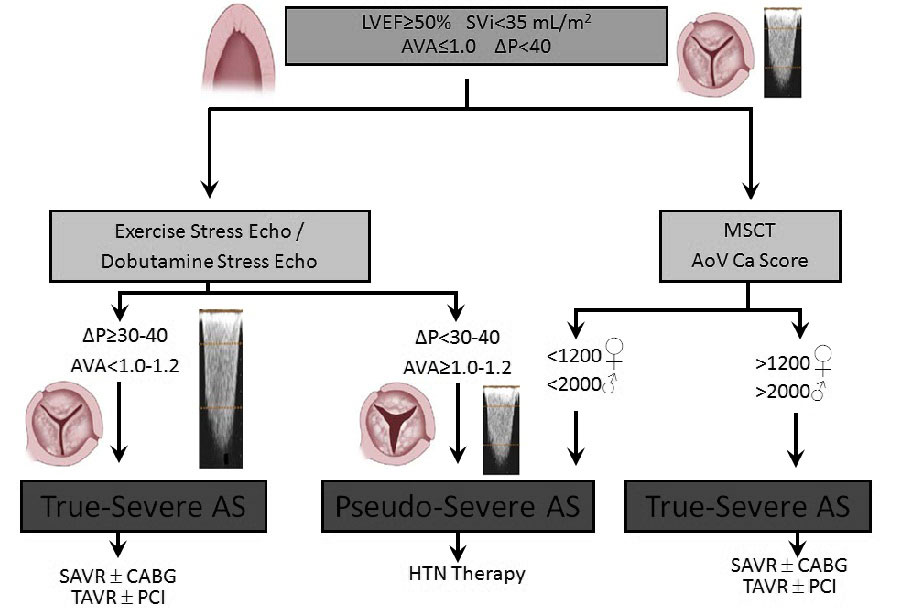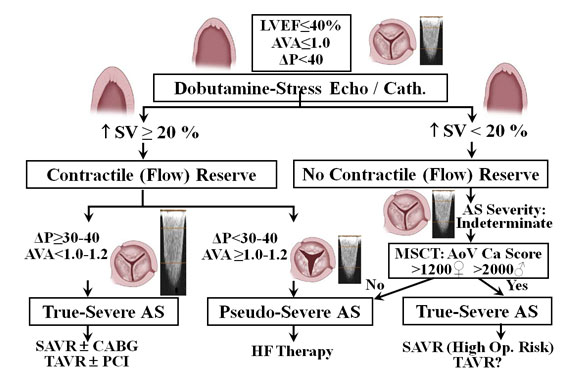low flow low gradient aortic stenosis guidelines
Svi 35 mlm 2 the guidelines state. AVA aortic valve area.

Confirmation Of Aortic Stenosis Severity In Case Of Discordance Between Aortic Valve Area And Gradient Sciencedirect
Other methods such as cardiac catheterisation are not routine except where the data is non-diagnostic or discrepant with clinical data.

. There are four hemodynamic variants of severe valvular aortic stenosis AS 1 Asymptomatic severe AS with preserved left ventricular LV function 2 Symptomatic severe AS with either preserved LV function or LV dysfunction 3 Low flow LF low gradient LG aortic stenosis with severe LV dysfunction 4 LF LG AS with preserved LV function. Low-LVEF Classical Low-Flow Low-Gradient LVEF25 SV42mL MG25mmHg. Low-flow low-gradient aortic stenosis is a difficult entity to diagnose and treat.
True-severe classical and paradoxical low-flow low-gradient aortic stenosis can be distinguished from pseudo-severe aortic stenosis by dobutamine stress. Aortic stenosis guideline published The British Society of Echocardiography BSE is delighted to announce the publication of a new aortic stenosis guideline updating previous guidance to reflect contemporary practice. High gradient severe as the 2020 american heart associationamerican college of cardiology valvular heart disease guidelines identify severe aortic stenosis as by the presence of an aortic transvalvular velocity 4 ms andor mean transvalvular pressure gradient 40 mmhg.
Once the distinction is made. Highlights in this focused update on aortic stenosis document include. JACC 2014 In Normal or High flow Conditions SV 35 mLm2.
Low flow is defined in the guidelines as a stroke volume index stenosis severity in presence of low flow. SVI stroke volume index. True-severe classical and paradoxical low-flow low-gradient aortic stenosis can be distinguished from pseudo-severe aortic stenosis by dobutamine stress echocardiography andor multidetector computed tomography.
Lf lg as is characterized by combination of severe aortic valve stenosis calculated aortic valve area ava. If normal flow and low gradient are confirmed these patients will in general not have severe as and do not benefit from intervention2 the concept that normal-flow low-gradient nf-lg pattern implies the presence of a non-severe as is still advocated by many. The aim of the.
LFLGAS low-flowlow-gradient aortic stenosis. AS grading algorithm- an integrated and stepwise approach. The new guideline comprehensively covers all aspects of the echocardiographic assessment of aortic stenosis.
Low flow low gradient aortic stenosis with preserved LVEF. In the setting of vhd and atrial fibrillation af except for patients with rheumatic mitral stenosis ms or a mechanical prosthesis the. In the presence of a normal flow ie.
N 2007 we reported that a substantial proportion of patients with severe aortic stenosis may have alowflow lf ie reduced stroke volume and thus often have a low transvalvular pressure gradient lg despite a preserved left ventricular ejection fraction lvef1the2014americancol- lege of cardiology accamerican heart association. The first step in patients with symptomatic PLF AS should be to rule out measurement errors and treat hypertension. Although the standard method for evaluation of aortic stenosis there are a number of situations in which data from.
Low-flow low-gradient LF-LG aortic stenosis AS may occur with depressed or preserved left ventricular ejection fraction LVEF and both situations are among the most challenging encountered in patients with valvular heart disease. LFLGAS occurs in 30 to 50 of patients with severe AS. 5 It shows an AVA low gradient.
Significant decrease in LV longitudinal function with a global longitudinal strain -149 despite a LV EF 63 Mean Pressure Gradient 25 mm Hg Peak max V 33 ms Stroke volume 28mlm² There is aortic stenosis with normal EF and mean gradient of 25 mm Hg. About 60 of patients with paradoxical low-flow low-gradient PLF-LG aortic stenosis AS have a severe disease that justifies aortic valve replacement AVR. On the other hand the AVA may be.
A low flow state is defined as a cardiac index 30 lminm2 or a stroke volume of 35mlm2. However as many as 30 of patients who have a calculated AVA in the severe range have other parameters suggesting mild or moderate disease ie mean gradient low-flowlow-gradient AS LFLGAS may truly have severe AS with resultant myocardial failure true AS or may have more moderate degrees of AS and unrelated. Various diagnostic modalities are needed to accurately determine the severity of aortic stenosis and potential treatment benefit.
Paradoxical LF-LG AS occurs in 5-15 of patients with AS2 and it is defined as a preserved LVEF 50 a low LV outflow ie. Echocardiography has become the standard method for evaluating aortic stenosis severity. New classification of AS by gradient flow and ejection fraction.
The guidelines also acknowledge that lower gradients may be observed in. Flow dependence of Velocity Gradients Valve MotionOrifice 2182018 2 Indicator Mild Moderate Severe Jet velocity 30 ms 30 40 40 ms Mean gradient 25 mmHg 25 40 40 mmHg Valve area 15 cm210 15 10 cm Aortic Stenosis AHA ACC Guidelines Nishimura R. In the American College of CardiologyAmerican Heart Association guidelines the criteria for severe aortic stenosis are an effective orifice area less than10 cm or less than 06 cmm a transvalvular mean gradient greater than 40 mmHg and a peak aortic jet velocity greater than 40 ms.
A LF-LG severe aortic stenosis is defined as an aortic valve AVA 10 cm2 or indexed 06 cm2m2 a mean transvalvular gradient 40 mmHg and a LVEF 40. Low flow low gradient aortic stenosis with reduced LVEF. Various diagnostic modalities are needed to accurately determine the severity of aortic stenosis and potential treatment benefit.
The aortic valve area ava is typically 1 cm 2 with ava indexed to. LVEF left ventricular ejection fraction. The second step is to distinguish pseudo-severe from true severe AS TSAS.
Both DTI and Deformation evaluation suggest impairment of longitudinal function. Stroke volume index low gradient. In both cases the decrease in gradient relative to AS severity is due to a reduction in transvalvular flow.

Complex Scenarios Paradoxical Low Gradient As In Normal Patients

Prognosis Of Severe Low Flow Low Gradient Aortic Stenosis By Stroke Volume Index And Transvalvular Flow Rate Jacc Cardiovascular Imaging

Complex Scenarios Low Gradient In Low Ef As Patients

Pdf Low Gradient Aortic Stenosis Semantic Scholar

Low Flow Low Gradient Aortic Stenosis When Is It Severe American College Of Cardiology

Distinction Of Classical And Paradoxical Low Flow Low Gradient Download Scientific Diagram

Evaluation And Management Of The Patient With Low Flow Low Gradient Download Scientific Diagram

The Challenge Of Low Flow Low Gradient Aortic Stenosis Patrick T O Gara Youtube

Evaluation And Management Of The Patient With Low Flow Low Gradient Download Scientific Diagram

Low Flow Low Gradient Aortic Stenosis When Is It Severe American College Of Cardiology

Simplifying The Approach To Classical Low Flow Low Gradient Severe Aortic Stenosis A Renewed Emphasis On The Resting Transthoracic Echocardiogram International Journal Of Cardiology

Pdf Low Gradient Aortic Stenosis Semantic Scholar

Paradoxical Low Flow Low Gradient Severe Aortic Stenosis A Distinct Disease Entity Heart

Pdf Assessment Of Low Flow Low Gradient Aortic Stenosis Multimodality Imaging Is The Key To Success Semantic Scholar

Paradoxical Low Flow Low Gradient Aortic Stenosis Circulation

Low Flow Low Gradient Aortic Stenosis When Is It Severe American College Of Cardiology

Dobutamine Stress Echocardiography In Low Flow Low Gradient Aortic Stenosis Flow Reserve Does Not Matter Anymore Journal Of The American Heart Association